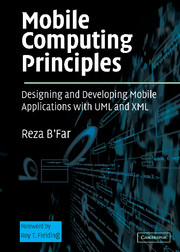Book contents
- Frontmatter
- Contents
- Foreword by Roy T. Fielding
- Acknowledgments
- SECTION 1 INTRODUCTIONS TO THE MAIN TOPICS
- SECTION 2 DEVICE-INDEPENDENT AND MULTICHANNEL USER INTERFACE DEVELOPMENT USING UML
- Chapter 5 Generic User Interface Development
- Chapter 6 Developing Mobile GUIs
- Chapter 7 VUIs and Mobile Applications
- Chapter 8 Multichannel and Multimodal User Interfaces
- SECTION 3 ADDITIONAL DIMENSIONS OF MOBILE APPLICATION DEVELOPMENT
- SECTION 4 PUTTING THE PROJECT TOGETHER
- References
- Index
Chapter 5 - Generic User Interface Development
from SECTION 2 - DEVICE-INDEPENDENT AND MULTICHANNEL USER INTERFACE DEVELOPMENT USING UML
Published online by Cambridge University Press: 03 September 2009
- Frontmatter
- Contents
- Foreword by Roy T. Fielding
- Acknowledgments
- SECTION 1 INTRODUCTIONS TO THE MAIN TOPICS
- SECTION 2 DEVICE-INDEPENDENT AND MULTICHANNEL USER INTERFACE DEVELOPMENT USING UML
- Chapter 5 Generic User Interface Development
- Chapter 6 Developing Mobile GUIs
- Chapter 7 VUIs and Mobile Applications
- Chapter 8 Multichannel and Multimodal User Interfaces
- SECTION 3 ADDITIONAL DIMENSIONS OF MOBILE APPLICATION DEVELOPMENT
- SECTION 4 PUTTING THE PROJECT TOGETHER
- References
- Index
Summary
You can't pick up two melons with one hand.
Persian proverbINTRODUCTION
We have now seen the basic tools we will use for the development process in creating mobile applications. The next step is to begin defining a methodology for building real applications and to show the implementation of the methodology in building these real applications.
Through the first four chapters, we discovered that, because of the condition of the mobile user and nature of the mobile application, the mobile application may interface with the user through a variety of devices and channels. In this chapter, we will take a closer look at the fundamentals of user interfaces to software applications, primarily mobile applications. We will focus on changing a paradigm shift in the application developer's thinking, moving him or her from thinking that an application will be used using a mouse, keyboard, and a monitor to thinking that an application may be used by a subset of any system input and output channel through which the user may receive stimuli from a system and respond to it. Finally, we will look at how to create user interfaces in layers so that we apply the principal of separation of concerns to orthogonal aspects of user interfaces. For demonstration purposes, we will use the XForms standard of W3C as an example for an XML-based tool designed to create the proper abstractions in user interface design.
- Type
- Chapter
- Information
- Mobile Computing PrinciplesDesigning and Developing Mobile Applications with UML and XML, pp. 231 - 315Publisher: Cambridge University PressPrint publication year: 2004



